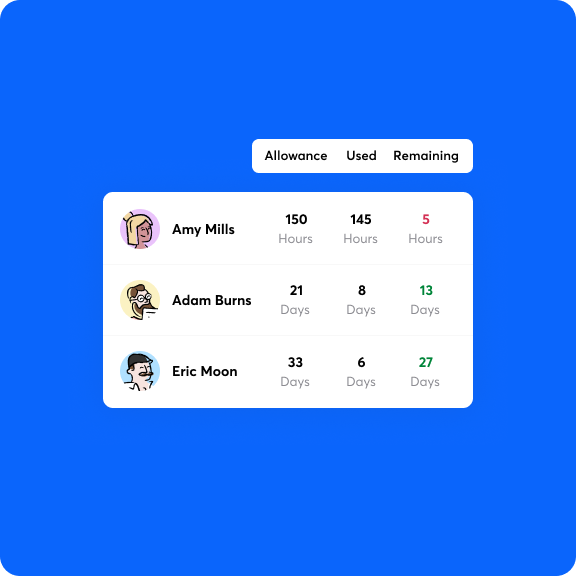Dealing with annual leave requests during peak periods
Understandably, employers want all hands on deck during peak periods. However, it's no coincidence that the busiest periods for retail and hospitality coincide with the most popular times for holidays.
Managers, then, likely find themselves between a rock and a hard place: ensuring they are both fully staffed and prepared during these peak periods and allowing staff to take the leave they’re entitled to - all while ensuring their holidays aren’t building up to create a backlog at the end of the year (which happens to be one of the busiest time for many industries!).
The most popular times to take annual leave (and to expect time off requests) are:
- Christmas to New Year
- Easter
- May Bank Holidays
- School Summer Holidays
- August Bank Holiday
(But we didn’t need to tell you that!)
Such leave requests can range from holidays away (especially in summer) to childcare around school holidays. You can’t stop staff from taking their entitled holidays - and you can’t discourage them, either. Doing so will likely increase sickness during peak periods, be it genuine due to stress or the opposite of having that originally declined leave. Whichever route, it leads you to being understaffed due to last-minute changes.
Let’s take a closer look
Data from 2023* reveals that the highest number of sicknesses are taken at the beginning and end of the calendar year. Out of the 541,583 total recorded sicknesses (from up to 186K people over the year), the Christmas period (from January 1st to 8th 2023 and throughout December 2023) alone accounted for 64,511 absences, representing 11.91% of the total.
The 4th of January 2023 saw the most people off sick (1.13%) that year - unsurprising as the day after New Year’s Bank Holiday! 9 days of December featured in the top 14 days of sicknesses, with the stretch between 12th-15th December 2023 alone sitting in the top 8.
As for summer, 130,000 sicknesses were recorded (of course, the majority being actual sicknesses!), representing 25.53% of the total absences, as the climb towards the backend of the year began. Interestingly, 19,000 of these occurred around Wimbledon (we’ll let you decide the coincidence or not!).
With this data in mind, avoiding this can seem like a minefield - and preparing your teams for peak seasons and battling the annual leave headaches sounds (and is) rough. But there are better ways to manage it.
So, how can you deal with the incoming influx of leave requests and avoid last-minute absences at your busiest time of year? We’ve broken it down into 3 suggestions.
1. Have a clear system for annual leave requests
First things first, you need to have a clear request system and leave policy. Seems simple enough, right? However, relying on text messages, emails, or even conversations isn’t accurate enough. Texts and emails get lost and are difficult to track, and you can’t wait for employees to come to you and voice their requests to you - especially when just the thought of that instils rampant anxiety in the best of us!
Look at the current UK holiday laws and remind yourself of the rules for holiday accrual, carry-over, and rolled-up holiday pay. It’s all difficult to track and calculate manually.
Think about:
- How you’ll take leave requests from staff
- Communicating clear deadlines and notice periods for submitting requests
- Time limits for managers to respond to requests
- How you’ll track and monitor requests and existing leave
- Using templates for a rota spreadsheet or a shift swap request form
Without a clear system in place behind the scenes, the front-of-house service can easily be affected. It’s fine, though. You can protect your 5-star service when your operations are streamlined.
2. Plan ahead
When explaining your rota-woes to others, no doubt the consensus is to “well, just plan further in advance.” In hindsight, it may seem like a simple solution, but there’s a reason you haven’t been able to so far. There are many factors to consider, which alone can help managers reduce stress for their shift-based teams.
What are they, and what can you put in place to make ‘planning ahead’ as simple as it sounds?
Rules & embargo
- Create a leave embargo through leave request rules to block specific days or periods
- Have requests immediately declined if the maximum number of staff are already on leave
- It encourages staff to get requests in sooner and reduces last-minute leave
Availability
- Allow employees to set their availability, allowing them to feel more in control and you to build rotas with confidence
- With staff still working their hours, they won’t need to submit leave requests
- This is good for parents during school holidays, putting in certain days and hours to work around childcare
- You’ll have less admin, be fully staffed, and have more engaged, happier employees
Forecasting
- By collecting data and tracking reports for attendance, cover, and costs, you can ensure you’re fully prepared and within budget during busy periods
- Track employees’ Bradford Factor (either through our app or calculator)
- See your staff’s absence records, annual leave usage, and how often they request shift swaps or drops
Sharing (is caring)
- Post and share rotas at least seven days in advance
- The further in advance, the fewer last-minute changes can be
- Give staff full transparency on when they’re working and how much they’ll be paid so they can plan their lives
Scheduling techniques
- How will you prioritise requests? It isn’t fair to entitle senior staff or use a first-come-first-serve model.
- Think about implementing a leave lottery to remove any sense of favouritism
- How about staggering holidays so everyone can get some much-deserved time off during the most stressful periods?
- Simply knowing how to make a fair rota can make happier staff and workplaces
3. Offer perks!
Gone are the days of the simple work-for-a-wage exchange. Times have changed and staff highly value more benefits at the workplace. Adding such perks can draw more applicants to your business and improve retention rates.
But we’re talking about annual leave, here. What processes and perks can you put in place around annual leave that can benefit employees while not impacting your peak periods?
- Think about holiday bonuses, overtime pay, or leave carry-over
- You can offer TOIL to ensure extra cover during busy times
- Offer open shifts for staff to have the choice to work extra hours
- Consider the option for staff to buy and sell holiday
- Introduce birthday leave
All of the above can help staff maintain a work-life balance that suits them and incentivise working extra hours to take holidays at quieter times.
Wrap-up
Just as your peak periods are important, so is being best prepared for them. A massive contributor to this is introducing better annual leave management to be better organised.
Being able to plan, easily track and manage leave requests, offer employees perks and more control, and have full sight of staffing levels - you’ll find yourself with more engaged staff, less stress, and fewer last-minute absences.
What makes it better? Having it all in one place.

Hassle-free holiday management
Self-service tools for your staff, effortless leave management for you.
*Source: Data collected from 186,000 RotaCloud users

